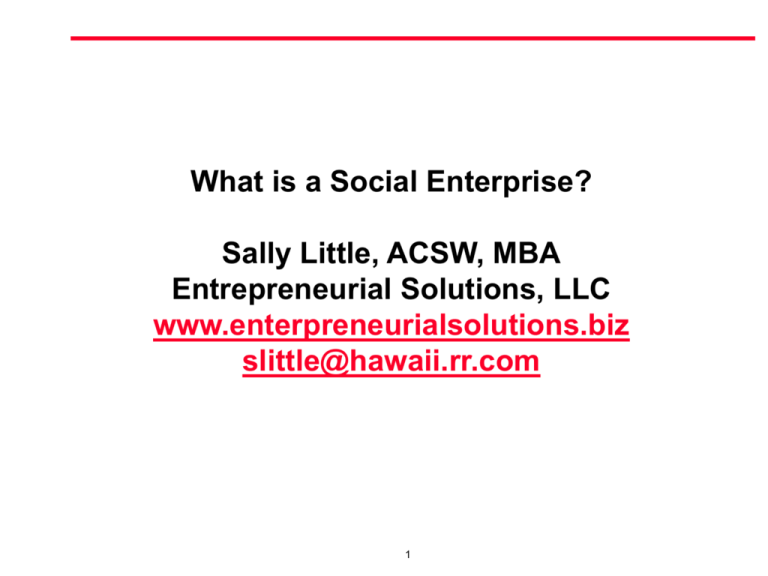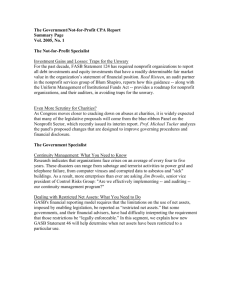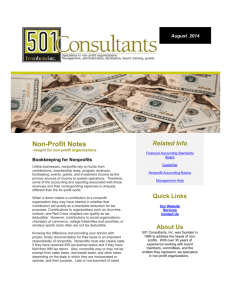What is Social Enterprise?
advertisement

What is a Social Enterprise? Sally Little, ACSW, MBA Entrepreneurial Solutions, LLC www.enterpreneurialsolutions.biz slittle@hawaii.rr.com 1 Social Enterprise Track Social Enterprise includes both nonprofit and for-profit organizations focused on delivering a double bottom line – financial and social returns Profit/Mission Continuum Focus for Social Enterprise Track Mission- Traditional Nonprofit focus Activities Tax-exempt, Social return on investment through achievement of mission Objectives Mercy Corps American Cancer Society Businesses with Social Outcomes Business mission-related activities that are not commercially motivated Definition Examples Nonprofit Earned Income A for-profit company that pursues financial return and simultaneously generates social outcomes activities that generate earned income to support a nonprofit mission Financial Financial and social return on investment and social return on investment Greyston Bakery Pioneer Human Services Conducted by Nonprofit Organizations 2 Edison Schools Microfinance Solar/green power cos. Traditional Business Activities Activities motivated by the primary purpose of returning profits to shareholders Financial return on investment General Motors American Express Conducted by For-Profit Organizations Profitfocus Social Enterprise Track The UH Business Plan Competition is reflecting growing trends of incorporating social outcomes by adding a Social Enterprise Track Businesses held to increasing socially responsible standards Businesses developing cause related marketing partnerships with nonprofits UH Business Plan Competition Social Enterprise Track Development of social enterprise curriculum at leading business schools Increasing earned income (business venture) activities in nonprofit sector Growth of socially responsible investment funds 3 Definition of Social Enterprise Social enterprises are defined as nonprofit or for-profit business ventures that strive to achieve a quantifiable double bottom line of financial and social returns. These ventures are financially selfsufficient. 4 Double Bottom Line Social return on investment-Social impact Financial return on investment-Profitability 5 What is social return on investment? Quantifiable social impact of the venture 6 Types of Social Enterprises Nonprofits with income from products/services supplemented by external support and subsidies Nonprofits with income from products/services not supplemented by external support and subsidies For-profit company that pursues financial return and simultaneously generates social outcomes 7 Wai’anae Organic Farmers Cooperative Wai’anae Community Re-Development Corporation www.waianaeorganic.com Nonprofit with income from products or services that are provided or produced and supplemented by external support and subsidies. 8 3 elements of Waianae Organic Farms Mission- Operate a youth leadership development training program for low-income and at-risk youth using agriculture as the teaching methodology Social Return on Investment- Educate community on health and wellness, distribute organic fruit and vegetables via farmers markets, Café in Waianae serving organic foods, teach young men and women how to farm the land-Quantifiable Financial return on investment- $145,100 profit in 2004, Sales- $85,400, Grants-Fundraising-$154,200. 9 Goodwill Industries of Hawaii www.higoodwill.org Nonprofit with income from products and services that are provided or produced and are not supplemented by external support and subsidies 10 3 elements of Goodwill Industries of Hawaii Mission—Provide training, job placement, and support services to people with barriers to employment since 1959 Social Return on Investment—Served 6,470 people, placed 1,079 in employment-quantifiable Financial Return on Investment--$38,916 profit (figures 6/30/04) 11 Greyston Bakery www.greystonbakery.com A for-profit company that pursues financial return and simultaneously generates social outcomes 12 3 elements of Greyston Bakery Part of Greyston Foundation’s integrated system of nonprofit and for-profits that offer a wide array of community development programs including job training, housing, and child care. Mission- Social Return on Investment- Actively recruit and hire employees who have difficulty finding employment in the past. Management services provided by Greyston Foundation. Greyston Foundation is sole shareholder.- Quantifiable Financial Return on Investment- Yearly generate $3.5 million in revenues 13 Other Examples Edison Schools—For profit, www.edisonschools.com Stoneyfield Farms, www.stoneyfield.com Microlending, Unitus, www.unitus.com, Accion, www.accion.org www.fastcompany.com, Capitalists Awards 2006 14 go to Social Definition of a nonprofit tax-exempt corporation Generally talking about nonprofit corporation that has received 501(c)(3) tax-exempt status from the Internal Revenue Service Many tax-exempt classifications 501(c)(3) must be organized for one or more of the following purposes: — — — — — — — — Religious Scientific Charitable Educational Testing for public safety Literary To foster national or international amateur sports competition For the prevention of cruelty to children or animals 15 How does a nonprofit differ from a for-profit? Nonprofit is essentially owned by the community; It is governed by a board of directors that generally serve without compensation; there are no shareholders. Upon dissolution, all assets must revert to a 501(c)(3) that generally has a similar mission or the government; As a founder you cannot recover your investment at dissolution Profit in a nonprofit cannot inure for the benefit to the benefit of the board of directors and compensation for employees cannot be excessive Donations to a 501(c)(3) are tax deductible. 16 Social Enterprise Track To judge the social enterprise track entrants, UH will consider traditional business criteria as well as socially specific assessments Traditional Business Criteria (in line with UH’s current judging criteria) • • • • • • Feasibility of business model in chosen marketplace Marketability of product or service to customer base Potential for financial return Attractiveness for funding from additional investors Management team strength, experience, and readiness Sophisticated understanding of risk and contingency plans Social Enterprise Track Criteria • Integration of the venture’s social and financial missions — Is it reasonable to expect that the financial and social goals can be achieved simultaneously? Do these goals make sense together? • Social Return on Investment — How does the enterprise serve a social purpose — Are socially responsible core values expressed throughout the venture — What is the venture’s potential to meet its social goals — What is the social impact both monetized and non-monetized of this enterprise? 17






